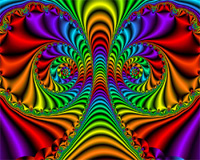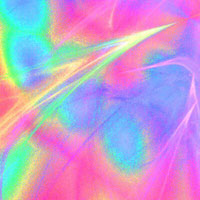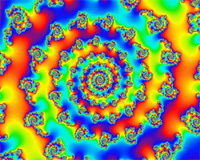1. What Light Illuminates
Colour Harmonics is the art of living in colour - of incorporating a thorough, conscious understanding of colour into the fabric of your life.
Why? Because on a subconscious and subliminal level, colour already affects every mood you experience, every decision you take, and every impression you receive. Like the air you breathe, colour is inherent to the process of living. Whenever you see, you see colour. When you dream, you will probably most often dream in colour - and often Technicolor! People who have been blind from birth still experience colour, and can sometimes identify colours by touch. This strange phenomenon suggests a theory we must investigate - that colour has some other quality beside that we see.
Why does colour affect us whether we know it has, or not? Is there some deeper significance in colour which, whilst not being obvious, still shapes our responses and attitudes? And if so, what is it? How does it work? And can we learn to harness this energy so that it enhances our lives? These are the questions which this Course sets out to try to answer.
There is a particular metaphysical theory which explains all of creation as vibration. Dense matter, like rocks, land or even people are seen as concentrations of vibration gathered together into one solid mass, whilst water and other fluids are seen as being formed from less concentrated vibrations. Then light, air, gas and sound are created by diffused and very rapid vibrations.

Whether you accept this theory will, of course, depend upon your point of view. However the idea presents some intriguing avenues of exploration. If all creation is composed from differing rates and patterns of vibration, then ultimately we all issue from shared beginnings. I am rock and flower and star and sea. And so are you! Each of us could be considered individual expressions of the same thing. Perhaps you feel that this is an interesting way to view the world, and all the people and creatures within it. Still, whether the whole theory fascinates you or not, on thing is sure. Colour owes its existence and manifestation to vibration. You see, colour is really a visible indication of light.
Light travels at a constant rate of 186,000 miles per second; it is presumed to make its wave-like motion from a series of vibrationery pulses emanating from a light source - in our case, the Sun - or any artificial lighting we use. Light’s rate of vibration is so high that we are unable to perceive its true form. Each individual vibration of light reaches our eyes so quickly after its predecessor that we see them all as one continuous effect. This rapid emanation is somewhat similar to that of sound waves - although of course sound travels much more slowly than light. We are all quite familiar with the pattern transmitted by radio stations, for instance - wave after wave of sound transmitted very quickly, in order to give the impression of continuous music or speech. Man has already broken the sound barrier. But save in the imagination of the sci-fi writers, no-one has as yet travelled faster than light. It’s often suggested that if man could find a way to do this, he would have discovered how to travel time.
Isaac Newton investigated light quite thoroughly. When he passed white light through a prism which bent its rays, he observed that the light split into seven colours. This process is called refraction, and is the effect which forms the basis of all our experiences of colour. Of course, refraction has been occurring naturally whenever the sun shone through rain from time immemorial, in the form of rainbows. Still, once Newton had reproduced the refractory effect of raindrops, it became possible to more thoroughly examine the colour spectrum.
One of the first facts to emerge from this research was that what we relate to as ‘colour’ has no material existence at all! Research showed that what our eyes see and report to the brain for interpretation into colour is, in truth, the specific effect of refracted and reflected light. Whenever light touches anything, a certain amount of it is reflected, whilst some is absorbed. It is this reflection we see.
We do not see light. We only see what it illuminates. We can only work out whether light is present by what we can see when light’s rays hit an object and bounce back into our eyes. This may sound a little confusing at first but you can try it for yourself. Look out of your window during daylight. You will see the objects beyond the window. You cannot see the light itself. Look out of the same window at night, and you will see much less. This is because there is less light available to reflect from the objects upon which it impacts. The reflections are therefore too weak to stimulate your eyes into action so you do not ‘see’ anything. The next section will thoroughly examine the way in which we see, and the processes by which we interpret what we see into useful information.
In the last century there has been substantial research into the psychological effect of colour. It is now widely accepted that there are certain common responses to particular colours. Colour apparently has a generally similar effect on everyone. Exposure to particular colours produces broadly comparable reactions in all who experience it. Interestingly enough, researchers do not yet appear to have taken the next logical step and tried to discover why this similarity exists. This omission is one of the reasons that we call Colour Harmonics the art of living in colour - following the oft-quoted thought that what art first envisages, science generally accepts eventually.
Later in the Course we shall examine why colour might produce the same reactions and effects in most people. For now, though, perhaps we could offer an idea for your consideration.

If, for a moment, we accept the hypothesis which suggests that all creation is vibrational in nature, then it is almost certain that we have an innate and unconscious ability to sense and interpret the vibrations which touch us in life. This might be seen as a deeply instinctual skill, and perhaps one which is less readily available to us now, than in the past - one which is lost to conscious understanding. Instead its function could be seen as subliminal - we see and register information below the level of conscious awareness, thus only outstanding pieces of information break through. We can identify certain peculiarities of experience which support this idea. For instance, do you experience a change of atmospheric pressure just before a storm breaks? And are you also aware of the calm after the storm, once the skies have cleared?
These might both be seen as the interpretation of changing climatic vibrations. Have you ever found yourself especially aware in places with strong psychic atmospheres?
Places of worship, for instance, retain the impression of the strong vibrations of their users. The land often retains the vibrations of emotions which have been felt upon it - battlefields and graveyards are good examples of this sensation. Have you ever, whilst driving, braked before you reach the bend and see a hazard? How often do you think of somebody immediately before they telephone you?
You will notice that we are referring to emotions and thoughts as vibrational in nature. Though we cannot prove this to be so, it seems a strong possibility. We experience waves of emotion. We are able, sometimes, to sense the emanation of emotion from others as well. Maybe each of us emits a constant stream of pulses which fills our immediate environment, and which may be ‘read’ by those who have the skill. We know from medical science that our thoughts register as tiny impulses of electrical energy in the brain.
Animals seem much more efficient than humans at reading these vibrational changes. For instance, in areas devastated by forest fires, animals are seen moving away long before the fire even starts. There are innumerable reports of birds and animals seeking shelter long before an earthquake occurs. Domestic animals know that their ‘people’ are coming home half an hour before they arrive, even when their arrival is unexpected. All of these reactions might be accounted for by an animal’s ability to read changes in vibrational pattern.
Of course, animals are still more in touch with their basic instincts than are humans. From the day we stood up and started talking, we have been moving away from basic instinctual behaviour patterns - and the skills therein. By creating the hi-tech world in which we now live, we have made a multitude of distractions which keep us too occupied to notice fundamental truths. Perhaps we’ve lost some of our ability to read vibrational changes as well.
So, what does all this have to do with colour, and the similar reactions it produces? Colour is a visible manifestation of light, and light is vibrational in nature. Furthermore light can be defined as a first principle of life itself. Every historical documentation of creation pinpoints light as the primary occurrence in the moulding of the Universe. The initial Biblical command is ‘Let there be light’. This is the first creative act. Buddhism regards light as synonymous with truth and exultation. The Chinese Yang force is light, whilst Yin is dark. Islam regards the light of the world to be Allah ‘ who illumines everything’. Even the Big Bang theory suggests an enormous explosion of light. And if you still aren’t convinced that light is a first principle of existence, imagine a morning without a sunrise. Light is important to our well-being and contentment.
Every time you see and interpret a colour you are experiencing the first principle of creation in action. Colour is a powerful agent by which to understand and interpret creation. So maybe in thoroughly understanding the meanings and effects of colour we can learn to understand a basic and fundamental principle of vibration - and in assimilating that basic principle into our lives and our consciousness, we must surely come closer to understanding how, why and who we really are.
We can’t see light. But we can see what light illuminates. And we can experience the reflected vibration of light as colour. So, by understanding colour, and consciously incorporating that understanding into our daily lives, we begin to harmonise with the first principle of creation. And if we can come into harmony with creation, then we become free, happy and fulfilled in our experience.

That’s the importance of Colour Harmonics. It teaches us to have a conscious awareness and understanding of colour - and consequently, a more efficient relationship with the light which creates it. By learning to interpret the effects of colour you can project more of yourself into your life; you can make an environment which supports your activities within it; you can protect yourself from irritation or manipulation by careless or unscrupulous use of colour qualities in the outer world.
The most interesting thing about the study of colour is that from the moment a student begins to explore light’s possibilities, they realise that deep down inside they already have a dormant awareness which becomes conscious and vigorous in no time at all. Once the process of awakening has begun, it has a life and energy all its own.
Strange, isn’t it, that man has searched high and low for a Holy Grail that he could have been walking around in all along?
